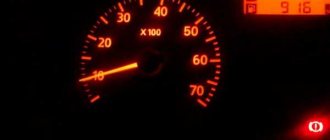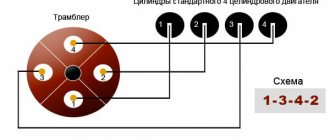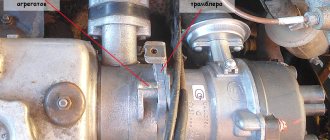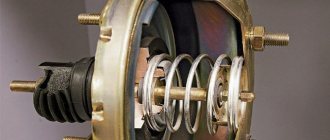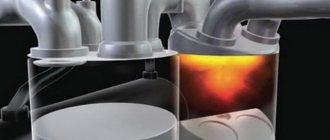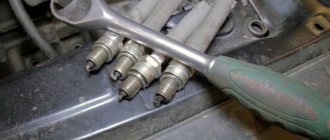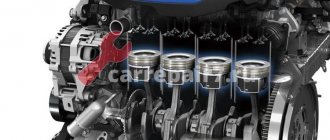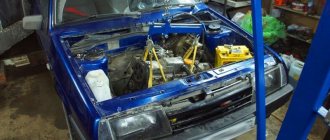Good afternoon The 2.4 engine stalls when accelerating, it feels like the ignition is late. Help me please! (Magamed)
Hello, Magamed! There can be many reasons for this, ranging from compression and spent spark plugs to the fuel filter. Of course, the problem may also be late ignition. If you had indicated the make of your car, perhaps our recommendations would have been more accurate.
Why does a car accelerate poorly?
Vehicle performance can be degraded due to many factors.
Below are the main reasons why an engine accelerates poorly:
- Incorrect motor operation. This may be due to a decrease in the compression level in one or several cylinders at once. In addition, the problem may be the leakage of additional air into the engine intake tract. Often the dynamics are disrupted when the intake system becomes coked or when the exhaust gas converter breaks down.
- Incorrect operation of the power system. If the fuel filter element or injectors are clogged. The fuel supply pipes may also be clogged. In some cases, problems are caused by insufficient fuel pump supply or the use of low-quality gasoline.
- Problems with the ignition system. When spark plugs have expired or there is a breakdown in high-voltage wires. A check needs to be done.
- If the sensors of the engine control system fail. For example, if one of the regulators breaks down, the ECU begins to function according to an additional backup program. Such a program is launched so that the motorist can get to the service station or garage. At the same time, the economic and power parameters of the motor are significantly reduced.
- When the clutch slips, which often occurs as a result of misadjustment or wear. A thorough diagnosis of the mechanism should be carried out.
- Insufficient air pressure in the tires. It is necessary to check and, if necessary, bring the pressure level to the required level.
- Also, deterioration in dynamics may be due to vehicle overload.
- Incorrect operation of the braking system, which may be caused by the wheels braking while driving or incorrect adjustment of the hand brake. There is a diagnostic option. You need to find a smooth road, preferably one where there is no wind during the test.
The point is to carry out a run-down run of the car. Refuel the vehicle; only you should be inside the car. The car accelerates to 50 km/h, after which the neutral gear is engaged and the car drives until it stops on its own. A similar procedure is repeated one more time, only in the opposite direction. You need to measure the car's run-out based on driving in both directions; on average it should be approximately 0.5 km.
Where to look for the reason?
Often the problem with the appearance of failures is associated with a malfunction of the vehicle's power system. Essentially, when you press the gas pedal, the driver forces the power system to increase the amount of fuel mixture supplied to the cylinders in the required proportions.
But a disruption in the operation of the system leads to a change in the proportions of the mixture elements, which is why the power plant is not able to increase the crankshaft rotation speed. A mixture with an insufficient amount of gasoline enters the cylinders, or vice versa - there is too much fuel.
It is possible that the cause of the malfunction lies in the ignition system, although due to it this problem is less common than due to the power system.
These same systems can be sources of causes during movement.
On cars with gasoline engines, two power systems are used - carburetor and injection. And although the carburetor power system is considered obsolete, there are still a large number of cars driving on the roads whose engine fuel mixture is prepared by a carburetor.
Dips when pressing the gas pedal more often occur in power plants with a carburetor, but this does not mean that such a malfunction does not occur in fuel-injected cars.
Next, let's look at what can often cause dips when you press the accelerator, and how to fix this problem using examples of cars with different power systems.
Video “How shock absorbers affect the dynamics of a car”
For details on how shock absorbers affect car acceleration, watch the video (video author - KYBRussia).
In general, despite the fact that I got the car in good condition and with only 50 thousand mileage, I just can’t understand what’s wrong with it... The essence of the problem
The problem is that the car accelerates too slowly. AND TOO TOO - THAT'S AN ENTITY TO SAY)))
It all started with the fact that I began to have problems when overtaking; I constantly did not have time to complete the overtaking and slowed down to return to my lane.
As if I don’t have much experience in driving, and this is my first car, and I don’t even know what acceleration should be like with a six, I decided to measure it, and was terribly upset when I accelerated to 100 km/h in 60 seconds...
In general, briefly about the condition of the car
Mileage: 50 thousand, without rewinding, one owner (my father), who has never driven it for more than 90 years. The condition is excellent, the compression was measured a couple of years ago, it showed 10 on all cylinders, now it may be less, but not by much, the car has practically not been used (2k mileage in 2-3 years).
Engine capacity: 1600 Gearbox: 2103 Gearbox: VAZ 2107, 5 mortar Gasoline: 92 Ignition: contact
Carburetor - DAAZ VAZ2107 GTZh 112, GVZh 150 The second chamber had jetters 150×150. There was a pneumatic system for opening the secondary chamber.
Measures taken:
1) I went to the service center, where they adjusted the ignition and carburetor and replaced the spark plugs with BRISC ones. After their adjustments, the car began to drive even more stupidly, as if they had configured it for maximum economy. Moreover, the consumption on the highway is 7 liters, in the city 10. I wouldn’t say that it’s economical.
2) I noticed that the second chamber on the carburetor does not work at all. I replaced the vacuum seal and blew out all the channels again. I pulled out the spring from the vacuum seal. As a result, the vacuum valve began to open at 6 thousand revolutions... Not at 3-3.5 thousand as we would like... The engine in neutral spins up to 6500-7000 revolutions, but when driving I could not spin it more than 4 thousand!
The car starts moving as if under a slight load, you have to increase the throttle to 2.5 thousand revolutions until a slight slip occurs.
Poor quality fuel
In approximately 50% of cases, the “culprit” for loss of traction is fuel. Due to its poor quality or inappropriate octane number (OCN), the engine does not develop power.
You can determine that there is inappropriate fuel in a car tank based on a number of signs:
- The engine started getting worse.
- There was detonation. This symptom manifests itself most clearly if fuel with the required octane number is diluted with gasoline with a lower octane rating.
- When examining spark plugs removed from the cylinder block (BC), you can see black or reddish (brick) carbon deposits, which are uncharacteristic of serviceable parts, which indicates the presence of unnecessary impurities. The first option indicates that gasoline does not burn completely, the second confirms the presence of additives containing metal.
- Ineffective spark plugs. This can be determined during a sharp increase in speed, when the engine has no reserve for further acceleration. The spark plugs may be clogged due to low-quality fuel or may simply have exhausted their service life.
Solving the problem is not difficult: the low-quality fuel should be drained and the tank filled with suitable fuel with the required octane rating. Clean the spark plugs from carbon deposits, and if their service life has come to an end, replace them with new ones, all at once, in a set from one manufacturer. When carbon deposits appear, you will again have to start diagnosing the cylinder-piston group (CPG) and (or) the fuel system.
5.1.5 The car accelerates poorly
5.1.6. The car accelerates poorly
There are many reasons for deterioration in dynamics, the main ones can be defined as follows:
1. Engine malfunction - decreased compression in one or more cylinders, changes in valve timing when the camshaft drive belt jumps, additional air leaks between the carburetor and the combustion chamber in the engine. Coking of the exhaust system.
2. Malfunction of the power system - clogging of the entire system, fuel filters, carburetor. Insufficient fuel pump supply. Incorrect carburetor adjustment (mixture too lean or too rich). Use of low-quality fuel.
3. Malfunction of the ignition system - failure of the spark plug, breakdown of the high-voltage circuit of the system, incorrect setting of the ignition timing.
4. Clutch slippage due to wear or misadjustment.
5. Malfunction of the brake system - braking of one or more wheels while driving, incorrect adjustment of the parking brake.
6. Insufficient air pressure in tires.
7. Vehicle overload.
Full diagnostics of the car should be carried out by highly qualified technicians using special diagnostic equipment, so contact a car service center
.
You can do the following work yourself:
1. Check and adjust tire pressure to normal.
2. Check the operation of the service brake system and parking brake. It is not necessary to remove the wheels for this. Find a flat section of the road and, in dry, windless weather, conduct a run- down
car. The car must be fully fueled, with only the driver in the cabin. Accelerate the car to 50 km/h, level out the speed, then switch off the gear and coast until it comes to a complete stop. Make another run in the opposite direction. The run-out should be about 500 m.
3. Check the operation of the carburetor and ignition system as described above.
| 4. Try increasing the ignition timing. To do this, having previously noted the initial position of the distributor, turn it one scale division clockwise when viewed from the side of the distributor cover. |
Warning
Take it for a test drive. If, after increasing the ignition timing during sharp acceleration, detonation appears - you hear loud metallic knocks lasting more than 2 seconds (the so-called knocking of fingers), the ignition timing will have to be reduced to the original value. Operating the engine with detonation is strictly unacceptable!
5. Check clutch operation.
The initial check is carried out on a level area free of obstacles. Set the choke control knob to a higher idle speed - approximately 1500 rpm. Depress the clutch, engage first gear and press the brake pedal. Then begin to smoothly release the clutch pedal. If the engine stalls, the clutch is working properly and is not slipping.
In this case, check the clutch drive adjustment. (See “Adjusting the Clutch Actuator” below.)
If these measures do not give the desired effect, contact a car service for a complete diagnosis of the car.
Clutch drive adjustment
| EXECUTION ORDER |
Dirty air and fuel filters
If the first of them is clogged and does not allow air to pass through well, the mixture will be excessively rich, that is, it will contain a lot of fuel, which will no longer burn completely. As a result, engine thrust will drop. If the fuel filter is dirty, the result in terms of the operation of the power unit will be the same, with the only difference being that the mixture will become very lean, because there will be little gasoline in it. Contamination of the air filter ahead of schedule can be caused by operating the machine in dusty conditions, and the fuel filter can be caused by low quality fuel.
Basic engine malfunctions
VAZ 2107 cars are equipped with three main types of power units with a displacement of 1.5, 1.6 and 1.7 liters. The second engine is equipped with a distributed injection system, which differs significantly from carburetor engines. During long-term operation, parts and components of the unit are subject to wear, which can cause the following malfunctions:
Diagnosis of injector or ECU malfunctions is carried out using a special tester, which is available at specialized service stations. Repair and restoration work on the engine is classified as complex and requires high qualifications and special skills.
Violation of valve timing
The main parts of the gas distribution mechanism (GRM) are the intake and exhaust valves. They are “obliged” to open and close only at the right moment so that the fuel mixture enters the cylinders on time and exhaust gases are removed. This process is called phase distribution. If it is violated, you will see that the power of the engine has disappeared, which will begin to “triple” and sometimes have difficulty starting.
Causes of valve timing violations:
- wear, as well as incorrect installation, displacement of the chain or timing belt (most often this is a jump by one tooth (link));
- play or deformation of the pulley on the crankshaft;
- wear of hydraulic compensators, camshaft and (or) its bed;
- burnout or rupture of the head gasket;
- Malfunction of the camshaft position sensor (DPRV).
To restore normal operation of the timing belt, it is necessary to set the position of the timing and crankshaft shafts according to the marks. If the chain is worn, replace it. The same applies to the camshaft with a bed, hydraulic compensators, gasket and DPRV.
Exhaust system resistance
Many people consider the only task of the exhaust system to be to muffle loud sounds and remove exhaust gases. However, modern cars are equipped with a catalyst that reduces the level of emissions of harmful substances. If this element is heavily contaminated or destroyed, the passage of gases becomes difficult. As a result, the engine works “as if strangled.”
In Russia, the problem is solved by simply removing the catalyst. However, you need to remember that in some car models such an operation will require changes in electronics (programming).
Violation of ignition timing angles
We are talking about the moment of ignition of the combustible mixture. It is this that is determined by the ignition timing angle (IAF). When it is deviated toward increase, the mixture ignites early, and toward decrease, it ignites late. Both options lead to improper engine operation and incomplete combustion of the mixture, which may be accompanied by popping noises in the muffler. On injection engines VAZ 2110, 211, 212, 214, 215 (there are also classics with an injector, for example, VAZ 2107), the OZ is set automatically, on carburetor VAZ 2101-2106, 07, 08, 09 (the last two models can be with an injector) it must be installed manually.
Signs of violation of OZ:
- difficult engine start;
- increased fuel and oil consumption;
- drop in throttle response and power of the power unit;
- unstable operation of the internal combustion engine at idle;
- The car does not respond well when you press the gas pedal.
The engine chokes when you press the gas
A fairly common situation during the operation of a vehicle is when failures occur when pressing the gas pedal, the engine stalls when over-accelerating, the power unit does not pick up speed, choke, etc.
From this article you will learn about the reasons why the power unit responds to pressing the gas pedal with a delay or does not develop power.
Let's start with the fact that there can be many possible reasons for this type of malfunction. In the process of initial diagnosis, an important condition is the observation of characteristic symptoms, which allows you to more accurately and quickly determine the malfunction. Next, we will look at why the engine stalls when you press the gas pedal, as well as in what cases the engine stalls when you press the gas.
Adjusting the OZ on an injection engine
Everything here is controlled by electronics. First you need to make sure that it is functioning properly and that the throttle sensor is working properly. At idle, it should be slightly open by about 1% (if this is not the case, set up a mechanical drive), the normal voltage at its contacts is 0.45-0.55 V (the car’s bot network should produce 13-14.3 V). When you sharply press the gas pedal, the damper should open 90", and the voltage on the sensor should increase to 4.5 V. If this is not the case, you need to adjust the damper drive and check the serviceability of the sensor (TPS).
To do this:
- take the tester and place it in the voltage measurement position;
- disconnect the connector from the sensor - you will see three contacts - one goes to ground, the other to the ECU (which one is connected where, determine from the diagram);
- start the engine and check the supply voltage - it should be approximately 5 V;
- turn off the engine and switch the tester to resistance measurement mode;
- with the damper closed, between ground and the contact going to the computer, the device should show 0.8-1.2 kOhm;
- with the damper open, resistance is 2.3-2.7 kOhm.
If the received data does not correspond to the above parameters, the sensor must be replaced. If this does not work, you should check the ECU.
Dips on a carburetor car
First, let's look at the VAZ-2107 car, which has a carburetor power system.
In most cases, the occurrence of a malfunction indicates a clogged fuel system. Therefore, the first thing to check is the supply of gasoline to the carburetor.
Severe clogging of fuel lines, air leaks, and decreased performance of the fuel pump due to damaged membranes lead to the fact that an insufficient amount of fuel is supplied to the carburetor.
For example, a car starts easily and the engine runs stably at idle, but as soon as you press the gas pedal, dips appear.
If the throughput is reduced due to clogging or the pump pumps an insufficient amount of gasoline due to its malfunction or air leakage, then when the accelerator is applied, the carburetor does not supply the required portion of gasoline.
Checking the performance of the fuel pump and the capacity of the fuel lines is done by disconnecting the pipe going from the pump to the carburetor and lowering its end into a container.
Setting the OZ on carburetor engines
The simplest and most effective way is to use a regular 12-volt light bulb.
- Rotate the crankshaft pulley until the marks match (on the cover - this is the central mark) using a special spanner. If it is not there, turn on 4th gear and push the car until the marks match.
- From the ignition breaker (distributor), disconnect the thin wire going to the coil and attach a light bulb to it, the second contact of which is connected to ground.
- Loosen the nut securing the distributor (usually it is a “13” wrench).
- Turn on the ignition, make sure that the lamp is on, and slowly turn the distributor around its axis until it goes out.
- Now turn the distributor again until the light flashes, and immediately tighten the distributor fastening nut.
Malfunctioning spark plugs
The planned replacement of these elements of the ignition system is carried out after 20-30 thousand kilometers. If the spark plugs are platinum, the resource increases to 100 thousand km. However, the situation when candles (most often one of them) fail ahead of schedule is not uncommon.
This can be seen and heard by a number of signs:
- the engine starts with difficulty, especially in winter;
- idling is unstable, the tachometer needle jumps, the engine may stop periodically;
- when the power unit is operating, increased vibration is observed, for example, the gearbox shift lever shakes;
- poor acceleration dynamics - the car does not develop full power, it stalls;
- when you press the accelerator, “dips” are noticeable;
- fuel consumption has increased.
When one spark plug does not work, experienced drivers say that the engine is “troubling,” that is, only 3 out of 4 cylinders are working.
To find a faulty part, you need to:
- put on dielectric rubber gloves;
- with the engine running, disconnect the high-voltage wire from each spark plug one by one;
- in this case, the nature of the engine’s operation should change, the speed should drop, but if this does not happen, it means that the cylinder is not working - the spark plug does not produce a spark.
It is worth finding out the reason for the poor performance of the part; it is quite possible that it is defective. If other spark plugs subsequently begin to fail, you will have to look for the cause elsewhere - the CPG or the fuel system.
All about the VAZ-2107 carburetor
Stable, smooth and economical operation of any gasoline engine can only be achieved if it is provided with a perfectly balanced mixture of air and gasoline. Fuel injection systems were installed on the “Seven” only in the last years of its production. And before that, the VAZ-2107 carburetor was “out of competition”; almost without any electronics, it prepared, according to the “recipe” built into it, gasoline-air power for engines of the entire “VAZ” line. Dosage systems in devices around the world were used in a variety of ways. On the carburetors of VAZ cars, one was chosen in which a float is used to maintain a constant level. Let's look at its design and operation using the example of the DAAZ 2107-1107010 “Ozone” .
The carburetor is a “harmonious orchestra” of different systems
In a musical orchestra, the playing of a variety of instruments merges into beautiful music, and in the same way in a carburetor, the “music” of the operation of all systems merges into the “song” of the engine in all possible modes of its operation. Let's consider the main components in which these systems are hidden. Cover, brass float, needle valve, air damper (choke).
Carburetor float chamber cover
Carburetor body, float chamber, diffusers of the first and second chambers.
Carburetor body, float chamber, main elements
Throttle body, damper actuators.
Throttle body
Adjusting screws, accelerator pump
How does it work?
The fuel level must be constant
Gasoline is supplied to the inlet, which is a brass fitting. It is filtered by a mesh and poured into the float chamber. A light float made of thin brass floats up and, through a lever, plugs the valve hole with a needle. That's it, the level has been reached, gasoline no longer flows. And when gasoline leaves through the nozzles, the float falls down, the needle moves away from the valve and the “action” is repeated. So gasoline stays at the same level, no matter how much we “gas.”
Preparing a “delicious” mixture
A running motor “sucks” air into itself. Rushing after it, gasoline flows in a thin stream through the jets of the VAZ-2107 carburetor and enters tubes with holes - emulsion tubes . Air also gets into them. Having mixed with each other, they turn into a “foamy mass” - an emulsion.
Emulsion making process
This substance, a “semi-finished product” of the full mixture, spreads through the channels and feeds the idle system and the main dosing system .
Small diffuser of the main dosing system
When we “push”, drive with a load, the emulsion flies into the air stream and is crushed into small particles, resulting in a flammable mixture, where there is one liter of gasoline per fifteen liters of air. At good speed this is not enough, so the clever little thing called the econostat adds more emulsion and the car can go fast. But even this is not enough for the engine to “swallow” when it is necessary to sharply accelerate the car. an accelerator pump was “attached” to the side of the float chamber to the carburetor . It is a miniature analogue of a gas pump that supplies fuel from the tank to the carburetor. Here, too, there is a flexible rubberized diaphragm, which is activated when the gas pedal is pressed, “squeezing” additional gasoline in a stream from the sprayer directly into the diffuser. This “extra” fuel gives an increase in engine power during sharp acceleration.
How to control a carburetor
The speed and power of the engine depends on how much fuel and air enters its combustion chambers. To reduce and increase their number, throttle valves are installed in the lower part of the carburetor, connected through levers and rods to the gas pedal. The carburetors of the VAZ-2107 are made of two-chamber. Most of the time, the first chamber works; the mixture passing through its diffusers is quite enough for most needs. Only when the driver presses the pedal “all the way” does the valve of the second chamber open and it comes into operation, giving a significant increase in engine power. The drive for opening the damper of the second chamber operates from a vacuum (vacuum) in the intake manifold.
Idling - independent system
The engine idle speed of the latest carburetor models, and ours too, is provided by an autonomous system, which means separate jets, channels and adjustments. It is installed only in the first chamber and starts working when the throttle valve is fully closed. The transition from idle to load occurs using a transition system of two holes in the diffuser wall of the first chamber. Through them, at small throttle opening angles, additional emulsion flows, helping to smooth out the transition process.
Autonomous idle system channel
Despite its apparent complexity, the carburetor is a very simple and reliable device, which cannot be damaged even by bad gasoline, which “kills” the injection machine. Everything that is written above applies to the carburetor not only of the VAZ-2107, but also of some other rear-wheel drive models.
To understand everything even better, watch this video:
How do carburetor malfunctions manifest?
It can be quite difficult to distinguish carburetor malfunctions from problems with other engine systems. The most common of them are: – excessively increased gasoline consumption, black exhaust smoke; – “dips”: we give gas, and the car seems to rest against an obstacle, after which it sharply “tears” forward; – “inadequate” reaction to pressing the gas pedal, when the car either accelerates or slows down on its own; – poor, unstable, uneven operation of the engine at idle; – idle speed is too high or low, the engine “stalls”; – the engine starts with difficulty.
Compression reduction
Often, the reasons for loss of engine power can be associated with simple wear and tear of the power unit. Do not forget that a car aged about 100 thousand kilometers begins to lose its power by 10-15%. If you think the losses are excessive, you need to check the compression. Its nominal value is indicated in the documentation for the machine. For testing, you will need an inexpensive device - a compression gauge, which is a pressure gauge mounted on a hollow tube or connected to a rubber hose equipped with a tip. It is screwed into the cylinder block instead of a spark plug. Next, disconnect the high-voltage wire from the ignition coil. Crank the crankshaft with the starter and note the highest reading on the compression gauge. The operation should be repeated for each cylinder.
Compression check
Pressure below that specified in the instructions by more than 15% indicates wear of the rings, pistons, cylinder block walls, and valves. To solve the problem, you can bore the BC to the repair size, replace the piston rings, grind (or replace) the valves.
Automatic transmission malfunctions
One of the tasks of the gearbox is to transmit torque to the wheels. And if this process is disrupted, then the engine does not gain momentum. You step on the gas and the acceleration is sluggish. The whole point may be a slipping automatic transmission.
There are several reasons for this:
- low-quality gear oil or not what the manufacturer recommends;
- clogged filters;
- clogged valve body channels;
- faulty solenoids (in this case, slipping is observed “hot”);
- wear of friction clutches (maximum service life 200-300 thousand km);
- problem with the control unit.
Most of the above faults are difficult to eliminate in a garage. Therefore, you will have to use the services of a specialized technical station.
If the carburetor engine does not pull
A carburetor is a mechanical device for preparing a combustible mixture of fuel and air. If the proportions of the components in this mechanism are violated, then the engine does not pull.
You need to adjust the carburetor in stages:
- Jets. Check their calibration - the part supplying air must have a larger diameter than the one through which fuel is supplied.
- Throttle valve. When you press the gas, it should open completely (if this is not the case, adjust the drive).
- Ignition system. Its contact version was discussed above. To check the contactless system, turn on the ignition and look at the dashboard voltmeter - its needle will approach “12”, and after a second it will rise higher. If there is no voltmeter, install a known-good switch and check the operation of the ignition system again.
Standard carburetor
VAZ carburetor engine does not pull
A carburetor is a mechanical device designed to create a mixture of air and gasoline, with further supply of this mixture into the combustion chamber of the engine. Problems with a lack of engine power at the carburetor are quite common and there are many reasons for them. We will try to deal with each one.
- Engine power system
First of all, the loss of engine power may be hidden behind the power system. As a rule, the engine does not pull due to a lack or excess of fuel. The fact is that gasoline and air are mixed in a certain ratio. And if one or another element is missing, the motor will begin to work unstably and will stop developing the required power.
The ratio of air to fuel should be within 15 to 1. If the amount of gasoline exceeds the permissible parameters, then it will not burn completely, which means it will reduce engine response. In addition, such a change in ratios will seriously increase fuel consumption and subsequently lead to other engine malfunctions.
An insufficient amount of fuel even leads to “starvation”. The ignition of the air-fuel mixture will be insufficient and the piston will move slowly. All this is achieved by correct carburetor tuning, precise selection of jets and many other factors.
Setting up a VAZ carburetor begins with the selection of jets. An important condition is to have a larger nozzle for air than a nozzle for gasoline. Then the carburetor float chamber is adjusted, which should only be half filled with gasoline. After this, the car engine starts and the quantity and quality of fuel is adjusted in accordance with the technical literature for this carburetor model. If, at the same time, a stable speed is achieved within the range of 800-900 rpm, then the carburetor adjustment was successful.
Another link in the power system is the presence of clean air and fuel filters. If the filters are too dirty, then fuel or air will pass through with great difficulty, which also disrupts the composition of the mixture. Therefore, filters must always be kept clean.
Also check the throttle valve actuator. It is possible that it does not open completely. In this case, stop the engine and adjust the throttle position.
It is also quite possible that the fuel pump has stopped creating the required pressure. To do this, you need to remove it and check it. It is quite possible that the drive and its diaphragm will have to be changed. There is another very common malfunction - increased wear of the fuel pump rod. This means that when manually it pumps perfectly, but when you start the engine it works for a short time, then it loses power and the engine stalls.
- Valve assembly
Why does an injection engine lose power?
The peculiarity of this engine is a fuel pump that works like an electric motor. If it does not work correctly, the engine speed will be unstable in all ranges. That is, fuel will be supplied unevenly, which will lead to a drop in the power of the power unit. The pump may not work well due to a dirty filter - it needs to be checked and cleaned if necessary. Another reason for the loss of power in an injection engine is the inefficient operation of the injectors, which become dirty during operation. You need to carry out diagnostics using a special (or even homemade) stand and clean the parts or replace them with new ones. The next reason is the incorrect operation of the electronics. These could be sensors or the ECU itself. In the latter case, it is recommended to install a working unit or go to a service station.

